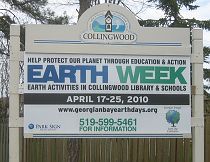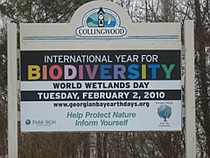Archive for November, 2019
Alliance of World Scientists Issue Bleak Warning
In 1972 the first United Nations Conference dedicated to the state of Nature took place in Stockholm. It spoke of the fragility of the planet’s ecosystems and helped spur the expanding interest in conservation. The UN Environment Programme was created in the same year to promote sustainability and stewardship for the Earth.
Seven years later, amidst growing concern about greenhouse-gas emissions, the First World Climate Conference was held in Geneva. This event was important because it laid out the internationally recognized concerns about climate change. Its Declaration stated: “Having regard to the all-pervading influence of climate on human society and on many fields of human activities and endeavour, the Conference finds that it is now urgently necessary for the nations of the world: (a) To take full advantage of man’s [sic] present knowledge of climate; (b) To take steps to improve significantly that knowledge; (c) To foresee and prevent potential man-made [sic] changes in climate that might be adverse to the well-being of humanity.”
Over the next nine years there were further gatherings of scientists and governments, culminating in the establishment of the Intergovernmental Panel on Climate Change.
tinyurl.com/history-climate-activities
Forty years after the Stockholm Conference, the Alliance of World Scientists (AWS) came together to issue a warning to the people of the world to take action. They expressed their concern in a preliminary paragraph: “Scientists have a moral obligation to clearly warn humanity of any catastrophic threat and to ‘tell it like it is.’ On the basis of this obligation and the graphical indicators presented below, we declare, with more than 11,000 scientist signatories from around the world, clearly and unequivocally that planet Earth is facing a climate emergency.”
tinyurl.com/aws-warning
It is some of those graphical indicators that I wish to share with you. They are important because they speak about more, much more, than just atmospheric change, which until now has received most of the attention. The graphs are divided into two groups: the first sets out the human activities that have changed our climate, and the second focuses on the impacts of those activities.
A human population graph begins the first list. In 1979 there were 4.4 billion people on Earth, and now there are almost 7.8 billion, spelling out massive hurdles for our planet’s ability to sustain life as we know it if we continue on this trajectory. Total fertility rate has dropped considerably since 1979 but is beginning to rise again. More than 220,000 babies are born each day – over 80 million each year. There are close to 4 billion ruminant animals (cows, sheep and others), belching huge quantities of methane, a potent greenhouse gas. Per capita meat production has risen sharply since 1979 (causing huge biodiversity loss). World Gross Domestic Product has risen 80.5% every 10 years – but remember that this reflects every kind of ‘product’, including cleaning up the devastation and pollution following disasters such as hurricanes and fires. And the graphs go on, covering tree loss globally and, specifically, in the Brazilian Amazon; fossil fuel consumption, which overshadows the advances made in renewable energy; and air transportation, which increased from half a billion flights in 1979 to almost 4 billion in 2019. (A small percentage of humanity take those flights.) Individuals’ carbon emissions are continuing to rise, fossil fuel subsidies are going up obscenely, and carbon pricing has crashed. The only good news has been more divestment from fossil fuel stock.
What have been the impacts of these changes? Atmospheric carbon dioxide has increased from 336ppm in 1979 to 413ppm in 2019. Methane and nitrous oxide – another greenhouse gas – have risen steadily, bringing surface temperatures to new heights. This alone defines our emerging climate crisis. In the last 20 years in particular there has been massive loss of ice in Greenland, the Arctic and the Antarctic, leading to higher and warmer oceans. Global glaciers, a major source of fresh water, have melted significantly, giving a billion people less security for their water needs. At the same time, ocean acidification continues, with disastrous consequences for coral reefs and other marine life. Finally, the graphs spell out the repercussions of extreme heat and fires. Sound bad? It is.
Do you think going out to buy discounted things on Black Friday is a good deal? It’s not. Make Black Friday a Buy Nothing Day! Over-consumption is both a symptom of the poverty of our inner lives and a direct threat to having a vibrant, balanced planet on which to live – and thrive. tinyurl.com/buy-nothing-day-2019
Questioning the Hypnotic Lure of Black Friday
Time magazine is famous for the ‘Person of the Year’ who adorns its cover each January, but in 1988 it decided to feature instead ‘Planet of the Year’: Endangered Earth. The image is of an embattled-looking Earth held together with twine. The precious Earth is frayed. The accompanying article, written by Thomas A. Sancton, is entitled ‘Planet of the Year: What on EARTH Are We Doing?’ These words could almost have been written today: “Now, more than ever, the world needs leaders who can inspire their fellow citizens with a fiery sense of mission, not a nationalistic or military campaign but a universal crusade to save the planet. Unless mankind [sic] embraces that cause totally, and without delay, it may have no alternative to the bang of nuclear holocaust or the whimper of slow extinction.” – Time, January 2, 1989. [tinyurl.com/time-what-on-earth]
By 1989, Bill McKibben’s book The End of Nature was spelling out the unfolding crisis of climate change. NASA climate scientist James Hanson had already told the US congress that greenhouse gas emissions were increasing as a result of the burning of fossil fuels and that this must stop. At the same time, trade deals were being signed and governments were more and more being asked by corporations to sideline climate-mitigation projects. So-called neo-liberalism and the advent of the outright hostility of extreme corporate capitalism (as well as Soviet-style communism) towards Nature and social justice has at its core the inability to end this climate emergency. We must recognize this! Thus it was that the 1992 Rio Summit turned into one more world conversation that ultimately did not move governments to act on solutions to save our endangered planet.
Naomi Klein’s new book, On Fire: The Burning Case for a Green New Deal, documents the unswerving attempts by corporate power to hamper efforts to ultimately save our planet and our last chance to find a just response to corporate greed through the Green New Deal that is being heralded by many as a solution for many of our ills. Here we are at the end of 2019, and fires are ravaging Australia. Australia’s government ‘leaders’ refuse to discuss the clear connection between climate breakdown and those deadly fires. On Fire also looks at our ingrained behaviour that fosters a constant reaffirmation and perpetuation of globalization and capitalist greed as well as the rise of the far-right nationalism, racism and ecocide of ‘Trump and company’: “Climate change demands that we consume less, but being consumers is all we know. Climate change is not a problem that can be solved simply by changing what we buy — a hybrid instead of an SUV… At its core, it is a crisis born of overconsumption by the comparatively wealthy, which means the world’s most manic consumers are going to have to consume less so that others can have enough to live.” With Black Friday (November 29) a few weeks away, the world is about to enact the grim spectre of overconsumption in hyper-mode. To counter this frenzy of buying things, Buy Nothing Day was conceived. And I’m told there are plans here in Sherbrooke to have some creative responses to Black Friday’s gluttony.
Naomi Klein’s first book, No Logo, chronicles the rise and power of the brand name — Nike, for instance — and the iniquity of the foreign sweat shops that make our clothes as well as everything else, while her book Shock Doctrine: The Rise of Disaster Capitalism graphically details how corporations profit when a disaster happens — New Orleans and Hurricane Katrina, for example. Over the span of 20 years, her books have documented the growing dangers to the world’s peoples and to biodiversity.
So what is the Green New Deal? It was inspired by President Roosevelt’s New Deal in 1930s America and the Marshall Plan to rebuild Europe after the second world war. Both schemes helped to give employment to millions of people. The Green New Deal aims to build on these successes to combat the war that is being waged against us and literally inflames the entire Earth. It is a response to the excesses of plutocracy that have led to the real possibility of climate chaos. What started with a few young and newly elected US congresswomen and an equally enthusiastic Sunrise Movement pressuring Washington Democrats has blossomed to unite many eco-socialist movements worldwide in demanding the end of racial and gender inequalities, protection of vulnerable workers, and universal health coverage, while we repair the damage of unlimited growth ideologies/market-based solutions and at the same time have a speedy climate-friendly transition to 100% renewable energy. The war on Nature, fanned by hideous austerity ventures by Donald Trump and his buddies, can be replaced by a Green New Deal that can rejuvenate democracy and end the climate crisis.
For more details about the Green New Deal, please see dataforprogress.org/green-new-deal-report

